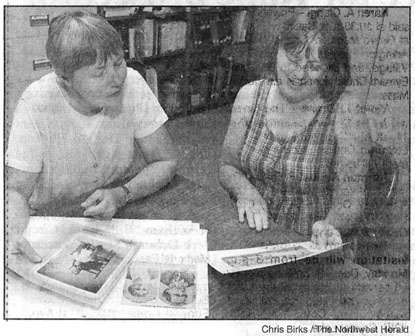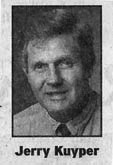
Nancy Fike and Ann Wells share an adventure out of the E. A. Burbank book, Burbank Among the Indians.

Nancy Fike and Ann Wells share an adventure out of the E. A. Burbank book, Burbank Among the Indians.

Curator hopes book placed by Yule tree
Jerry Kuyper
December 11, 1999
Northwest Herald, used with permission
UNION - It is the season to give gifts to family and friends, but Nancy Fike does not want anyone to forget McHenry County Historical Society, either.
She has in mind a very small gift that might almost be overlooked under the Christmas tree.
It is a 1944 edition of Burbank Among the Indians by E. A. Burbank. There is a first and only printing, which makes the 232 page book, including index, foreword and appendix, something of a rarity.
We do not have the book in our museum library, and I certainly would like to have one in it. Oh, how I'd love to get one of those books," said Fike, the museums curator.
The copy Fike devoured was checked out of the Delos F. Diggins Library in Harvard. That public institution is a proper repository for Burbank material as the artist and raconteur was born in the northwestern McHenry County village in 1858, a grandson of Elbridge Gerry Ayer.
The grandfather had roots in Harvard, Mass., before migrating west to name a settlement after his Eastern hometown in 1856. Two years later, along came the Burbank grandson. The grandfather pales in significance, though, compared to Burbank's uncle.
The uncle was Edward E. Ayer, first president of the Field Museum in Chicago and a trustee of the citys Newberry Library. The uncle noted the talents of the nephew and steered him toward a career that would gain him a certain notoriety, but also an insistent poverty.
After studying at the Academy of Design in Chicago and later on the continent in Paris and Munich, the uncle sent the nephew west.
The unc1e wanted Burbank to capture the dying era, if not the spirit, of the Indian tribes living west of the Mississippi River.
The west was being fenced in by farmers and ranchers and the Indians were disappearing into the barren lands reserved for them in states such as Oklahoma, Arizona, New Mexico, Oregon and South Dakota. Burbank traveled to every known surviving tribe, taking notes and drawing pictures. Burbank sent his materials to the uncle, who used them in displays at the museum to satisfy the curiosity of a public still aroused by the names of prominent 19th century Indian war chieftains. These included the great Apache Geronimo, as well as several Sioux responsible for the demise of Gen. George Armstrong Custer s command in 1875.
Burbank interviewed and painted, among others, Geronimo, Red Cloud and Rain In The Face. Rain is the Sioux who purportedly cut the heart out of Custer's brother at the battle of the Little Big Horn.
Burbank also gained the trust of Anisazi remnants in Arizona to witness their rattlesnake handling ceremonies. The book is replete with adventure and anecdote. Even the appendix is loaded with fascinating material concerning the first Christian missionaries to the Hopi and the interaction or lack of it.
Incidentally, one reason why Mr. Burbank can paint Indians lies back of the fingers and was not learned in the art schools. He cannot only see but understand. They are to him not merely line and color, but human character, a noted western historian, Charles F. Lummis, wrote in the foreword to the Burbank book.
More ignorant people, who fancy that aborigines are not quite men and women, might be enlightened - if anything can enlighten them - by talk with this unassuming painter. His ethnologic horizon is not scientifically exhaustive, but he has got far enough to understand the fact of human nature, and this is much deeper in wisdom than many who pass for scientists and write monographs of large words, ever made, Lummis continued.
Lummis, author of The Land of Sunshine, also suffers at the hands of pedantry, who have relegated him to the remaindered and forgotten shelves, just like Burbank. Even so, the star of Lummis shines much brighter than that of Burbank. Lummis, at least, still has books in print.
Caxton Printers of Caldwell, Idaho has no such intent for the Burbank book and, thus, its rarity. At Harvard, the book in a special collection, but it can be obtained through interlibrary loan. Evanston Library, for instance, has one copy. Fike, of course, does not have a copy.
Ann Wells, a genealogist and Burbank researcher from Crystal Lake, pointed Fike to the Burbank book earlier this year. Wells had latched onto Burbank for aesthetic as well as genealogical reasons.
I got interested in him several years ago, as here was this very artistic, accomplished man who has his drawings in museums and private collections the length and bread of this country, Wells said.
The Newberry has a small collection and, so far, the public relations staff at the Field Museum has uncovered not one Burbank canvas. The Smithsonian in Washington, D.C., and the Chicago Art Institute may have a canvas or two.
The bulk of Burbank's paintings are in the Butler Institute of American Art at Youngstown, Ohio. A Mr. Butler was sufficiently prescient to buy Burbank's personal collection for $13,500 in 1902.
Burbank apparently needed money as he had one, two, or three wives to support.
He married at least twice, but he may have had a third wife too, Wells said. She continues her genealogical research, which includes mundane requests for coroner's materials in San Francisco, Calif.
Burbank died impoverished in 1949 after complications of a street car mishap. I'm still pushing forward on this, Wells said.
His ashes, after an aborted stay at a burial site in Rockford, are in storage at Mount Auburn Cemetery in Harvard.
His paintings sometimes are reproduced in coffee table books, ideal for Christmas gifts, but Fike has something better in mind.
Burbank is an unsung hero. Hey, Merry Christmas everyone. Id just love to have a copy of his book. Is anybody reading this? Fike asked
![]()